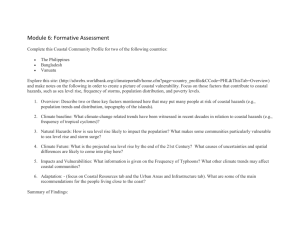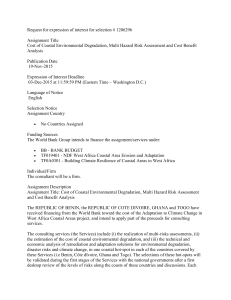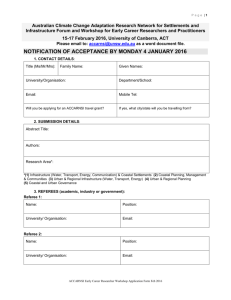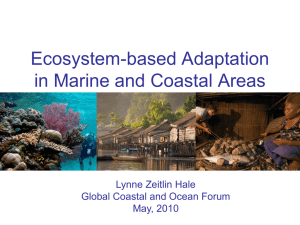Improving cross-sectoral climate change adaptation for coastal
advertisement
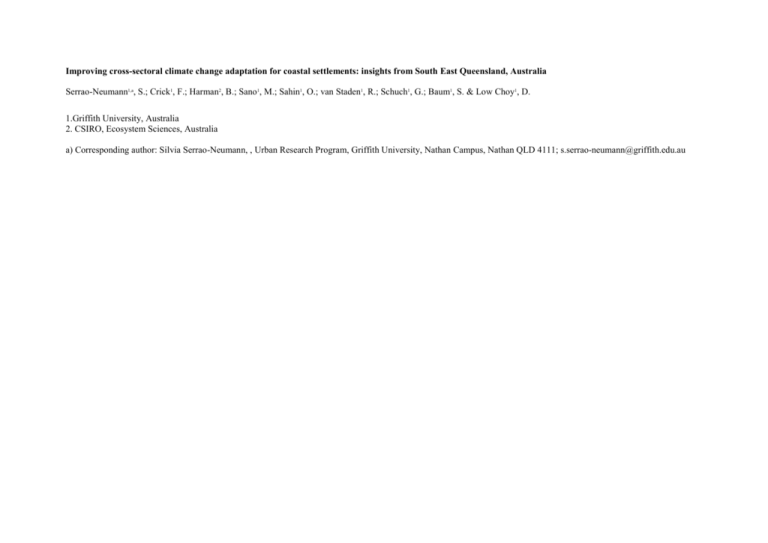
Improving cross-sectoral climate change adaptation for coastal settlements: insights from South East Queensland, Australia Serrao-Neumann1,a, S.; Crick1, F.; Harman2, B.; Sano1, M.; Sahin1, O.; van Staden1, R.; Schuch1, G.; Baum1, S. & Low Choy1, D. 1.Griffith University, Australia 2. CSIRO, Ecosystem Sciences, Australia a) Corresponding author: Silvia Serrao-Neumann, , Urban Research Program, Griffith University, Nathan Campus, Nathan QLD 4111; s.serrao-neumann@griffith.edu.au Table S1: Overview of the 3 coastal settlements and associated adaptation challenges Coastal Settlement Types Canal Estates – Blue Waters Description Beach Front High Rise Holiday Destinations – Sandy Shores Extensive residential precincts developed around Locations with high population densities artificially constructed waterways providing (including seasonal variations) and high amenity water-focused lifestyles; and property values; Low to medium density residential areas These areas have been modified significantly over comprising a combination of new, refurbished and the last 30 years for development and old (1970s) housing developments; infrastructure purposes, mainly through the Demographic profile tends to be mixed with both construction of canals and the protection of working-age households and older couple beaches against erosion; households, and average household incomes tend These areas have a large, fluctuating tourist to be similar or superior to the national average; population all year round; Sensitive to natural hazards, such as extreme Naturally dynamic environment surround by rainfall events, storms and storm surges, due to water which makes it sensitive to coastal hazards their coastal location, proximity to low-lying such as sea level rise, coastal erosion and storm flood plains and density of land use. surges. Climate change is likely to exacerbate their Adaptation Challenges Current coastal hazards likely to increase in current exposure to natural hazards and increase intensity due to climate change; their vulnerability; Fluctuating seasonal population needs to be Maintaining the current low to medium density considered when planning for health and residential profile while accommodating growth emergency services; and development pressures taking into Matching population and development growth consideration future climate change; with safety standards in planning and Maintaining and ensuring critical infrastructure infrastructure is critical to reducing vulnerability (e.g. roads and stormwater) and services (e.g. to future climate induced coastal hazards. emergency management and health services) can deal with a growing and ageing population and are upgraded or relocated to consider the future risk of floods and the need to maintain emergency and evacuation routes. Coastal Residential Suburbs - Greenhaven Large residential populations in low-lying flood prone location; Significant proportion of low-income households and higher than average unemployment rates, large immigrant community; Low quality and ageing housing stock; Dominance of rental accommodation including public housing; Sensitive to natural hazards, particularly floods. Increase in intensity and frequency of rainfall events due to climate change is likely to exacerbate their vulnerability; Accommodating growth while protecting the community from increasing risks from climate change impacts; Continuing to support communities with low socio-economic profile to reduce their vulnerability to future climate change impacts. Source: Low Choy D, Serrao-Neumann S, Baum S, Crick F, Sanò M, van Staden R, Harman B, Schuch G, Sharma V (2011) Hypothetical Case Study Elaboration, unpublished report for the South East Queensland Climate Adaptation Research Initiative, Griffith University Table S2: Selected adaptation options appraisal criteria Criterion Flexibility Robustness Source Fankhauser et al. 1999; Hallegatte 2009; UKCIP 2012 Hallegatte 2009 Equity Adger et al. 2005; Adger et al. 2009 Coherence/alignment (synergy) – alignment Coherence/alignment (synergy) – enhancement Hallegatte 2009; UKCIP 2012 Hallegatte 2009; UKCIP 2012 Acceptability – political, bureaucratic, community and private sector Avoidance of maladaptation – low greenhouse gas emissions Avoidance of maladaptation – less vulnerable populations Avoidance of maladaptation – low opportunity costs Avoidance of maladaptation – adaptation incentives Avoidance of maladaptation – low path dependency Adger et al. 2005 (based on legitimacy) Barnett and O’Neill 2010 Definition The extent to which the option is responsive and flexible to changing future conditions. The extent to which the option is able to operate efficiently and effectively across a wide range of variables/uncertainties; has no contingent on third parties (limited dependencies); has minimal impacts; and is not very risky. The extent to which the option does not place communities/regions/states in disadvantaged and improves current situation/inequity. The extent to which the option is consistent/aligned with other strategic objectives, measures, policy goals and sectors. The extent to which the option builds on or enhances the expected outcomes from existing policies/initiatives in place before the introduction of the climate change adaptation option. The extent to which the option is stakeholder focused (including politicians, decision makers, communities, private sector) and provides solutions that are acceptable to wide range of stakeholders. The extent to which the option does not increase greenhouse gas emissions. Barnett and O’Neill 2010 The extent to which the option does not contribute to burden vulnerable populations. Adger et al. 2005; Hallegatte 2009; Barnett and O’Neill 2010 Barnett and O’Neill 2010 The extent to which the option results in low or no opportunity costs (social, environmental and economic costs). Barnett and O’Neill 2010 The extent to which the option does not result in path decency, i.e. actions that do not limit choices available to future generations. The extent to which the option does not reduce incentives to adapt (planned and autonomous adaptation). Relevance to cross-sectoral integration Provision of scope to identify potential trade-offs between sectoral policies. Provision of scope to identify potential trade-offs between sectoral policies. Provision of scope to identify potential trade-offs across sectors leading to inequity. Provision of scope to identify potential conflicts and trade-offs across sectors; Promotion of comprehensiveness, aggregation and consistency across policy components, sectors and levels of governance. Provision of scope to identify potential conflicts between sectors in terms of sector specific resistance/ barrier to adaptation. Provision of scope to identify potential sector-specific adaptation policies that could increase greenhouse gases emissions. Provision of scope to identify potential sector-specific adaptation policies that could increase the vulnerability of population. Provision of scope to identify potential sector-specific adaptation policies that could lead to high opportunity costs to society, the environment and the economy. Provision of scope to identify potential sector-specific adaptation policies that could inhibit adaptation in other sectors. Provision of scope to identify potential sector-specific adaptation policies that could increase path dependency in climate change adaptation. Table S3: Examples of programs relevant to coastal settlements distributed across adaptation themes Adaptation Themes Preparing the Community Urban Planning & Management Coastal Erosion Risk Minimisation; Coastal Inundation Risk Minimisation; Flood Risk Minimisation Coastal Management Human Settlements Sector Physical Infrastructure Community capacity and engagement programs Emergency Management Human Health Preparedness of private and community sectors; Real estate sector and hazard awareness Community Capacity Building; Integration with Emergency Management Support for Vulnerable Communities Community Planning; Retrofitting of Residential Properties Preparedness of vulnerable communities; Community education and awareness raising campaigns for vulnerable groups Psychosocial Support Leadership, including Community Leadership Leadership Development Community Leadership Leadership Development through Collaboration Proactive (Anticipatory) Initiatives Strategic Relocation and Upgrade of Essential Emergency and Health Services; Long-Term (Strategic) Planning; Coordinated Response to Sea Level Rise; Land Use Conversion; Anticipatory Planning Response Management Long term post-disaster recovery plan; Post-disaster recovery in pre-disaster plans; Community engagement Service Continuity in Disaster; Heat wave Management; Improved Understanding Managing the (Urban) Environment Consolidation of Urban Development; Infrastructure Sites; Building Code Design Criteria; Planned Retreat; Coastal Defence; Redundancy and BackUp for Essential Services and Buildings; Protection of Coastal Habitats Beach nourishment in a changing climate; Dunes restoration in a changing climate; Storm tides defence system; Retreat from high coastal hazard areas; Restoration of coastal environments; Space for water; Design standards for buildings and infrastructure Operation of Roads; Operation of Stormwater System; Finance for Roads; Finance for Stormwater Systems; Implementation Emergency management integrated into land use planning and development; Emergency management integrated into state planning policies; Strategic relocation and upgrade of essential emergency services; Redundancy and back up for essential emergency management services and facilities Integration with Urban Planning & Management; Integration with Physical Infrastructure Technological Development and Innovation Innovative Design for Coastal Areas; Flood Immunity; Innovative Designs for Floods Innovative erosion control approaches Road Design; Stormwater Systems Design Risk Communication Training and Education Hazards Full Disclosure Clause; Risk Communication on Climate Change; Risk Allocation Mechanisms Capacity Building; Professional and Sub-Professional Education and Training Community Risk Awareness ; Improved Availability of Information; Risk Management & Population Health Enhanced coastal education Programs; Build capacity of institutions to manage coastal hazards Education Capacity building and training program; Local government emergency management capacity; Communication between local councils Supporting Volunteers


